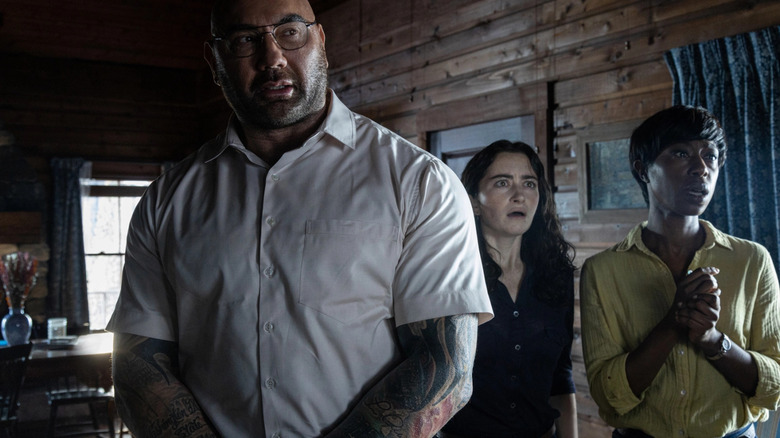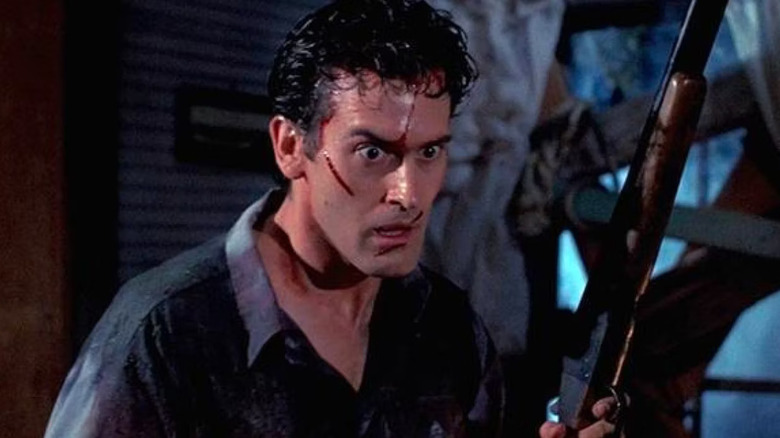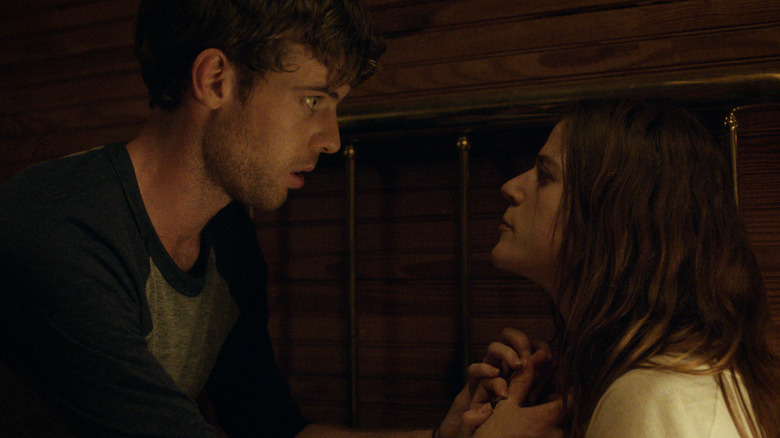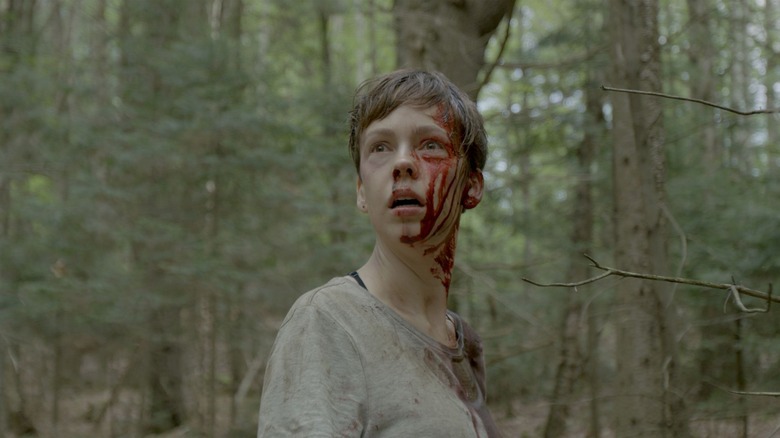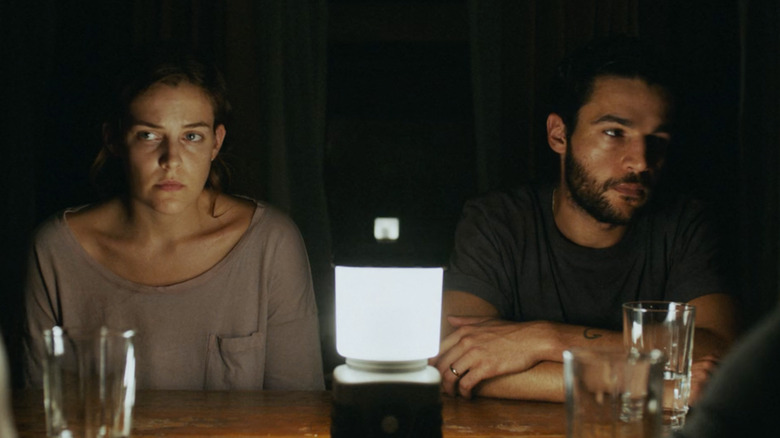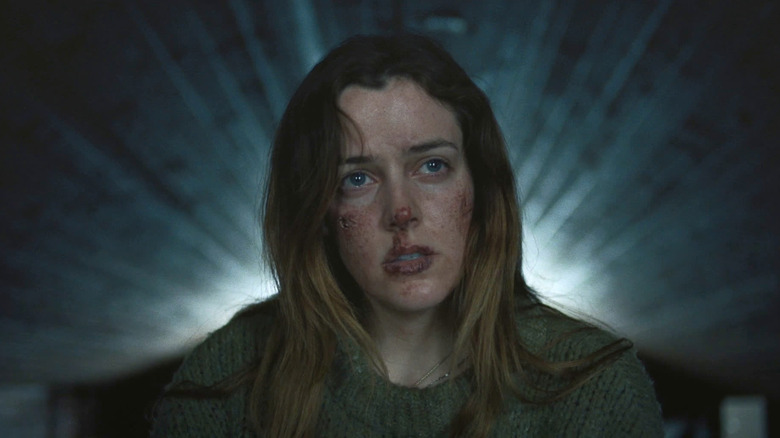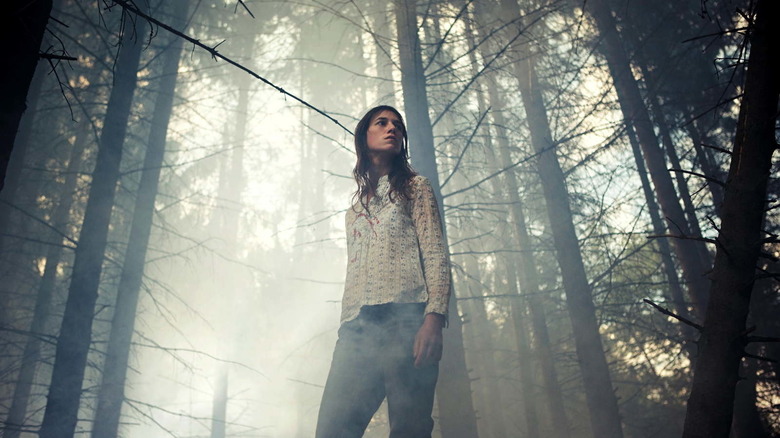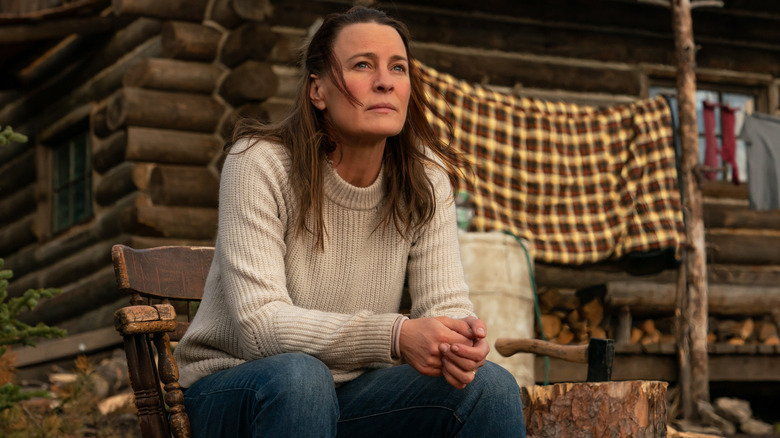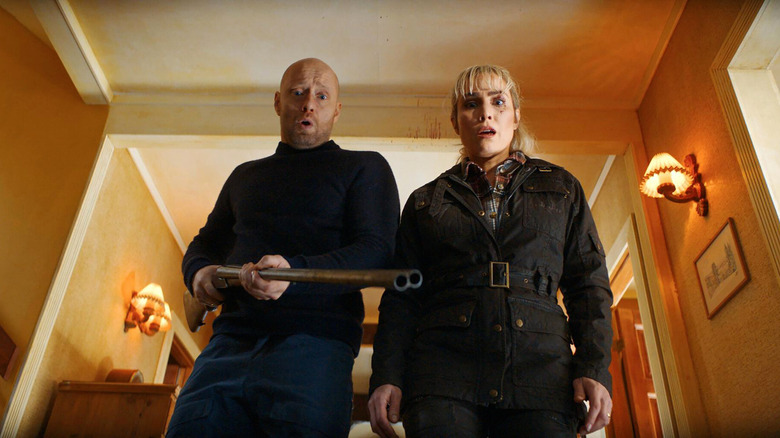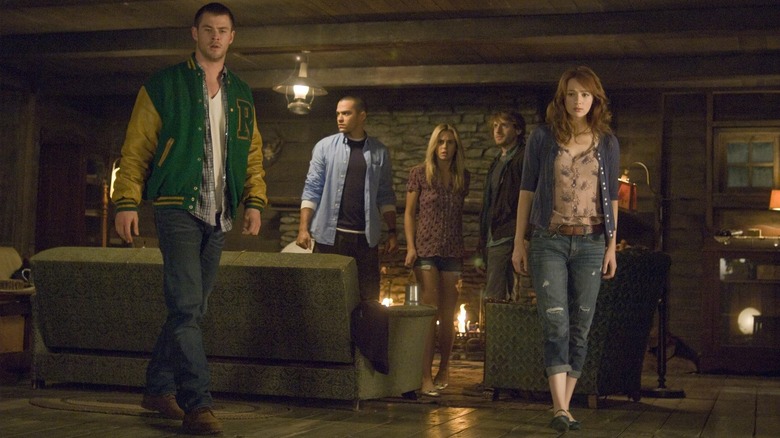9 Great Movies About A Cabin In The Woods
In M. Night Shyamalan's "Knock at the Cabin," a couple and their young daughter take a trip to a secluded cabin. Their peaceful vacation is interrupted by a group of strangers holding deadly weapons. It feels like a familiar hostage horror movie until the shocking revelation that the family must make a devastating choice to prevent the apocalypse.
"Knock at the Cabin" is just one of many films to use the cabin in the woods trope. This sequestered locale buried in the vast, mysterious woods is often the site of violence, confrontation, and hidden secrets in films — particularly the horror genre. It is a space where characters are forced to be together, and there is nowhere to run when they face danger. The wild, remote setting forces protagonists to confront life-altering circumstances and events. Often, these films are intimate with a small cast trapped in the cabin setting.
The cabin in the woods storyline does not just work for the horror genre, but also comedies or psychological dramas. This list explores how a variety of films utilize the setting to create captivating stories.
The Evil Dead series
Sam Raimi's "Evil Dead" set the standard for the cabin in the woods narrative in the horror genre. The first film, "The Evil Dead," is about five young college students who plan to party in an old, abandoned cabin in the woods where they accidentally read from the Necronomicon and release ancient Kandarian demons that take over their bodies and souls.
Raimi's dynamic camerawork makes the small space of the cabin feel creepy and alive. He uses point-of-view shots from the demon trapped in the cellar door to give viewers the feeling of being hunted like Ash and his friends.
"Evil Dead II" is more of a requel, featuring a similar plot with amplified comedic elements. It fully embraces its new identity as less of a straight horror and more of a schlocky, B-movie, especially in the scene where Ash goes mad when he's left alone to fight the undead. Ash starts maniacally laughing, joining in with the deer head mounted on the wall and bouncing lamps, couches, bookshelves, and other objects that have come to life. It's as if the entire cabin is mocking him for being trapped in this hopeless situation.
The 2013 reimagining of the original classic has a dour aesthetic. While the original "The Evil Dead" cabin is dark and terrifying, Fede Álvarez's setting is lit in muted, drab colors that match the reformulated plot about a group of friends heading to a cabin to stage an intervention. There is little to no humor, and the gore is grimy and lacerating. In this film, the demons are petrifying with their rotting skin and piercing yellow eyes. The trailer for "Evil Dead: Rise," which releases on April 21, seems just as horrific — if not more so.
Honeymoon
Cabins are typically a romantic spot for couples to enjoy each other in peace and quiet without any distractions. The horror movie "Honeymoon" takes the special post-wedding vacation and turns it into a terrifying experience. Newlyweds Paul and Bea are excited to celebrate their recent nuptials in a remote locale, but one night Bea goes missing. He finds her naked and confused in the middle of the woods. Was it sleepwalking or something more sinister lurking around the cabin?
Cinematographer Kyle Klutz bathes "Honeymoon" in a sickly yellow hue that represents Paul's fear and Bea's deteriorating mind after a strange sleepwalking incident. She slowly starts forgetting simple words or personal details about their relationship. In one startling scene, Paul discovers Bea mutilating herself.
Leigh Janiak's "Honeymoon" rapidly builds to an unnerving final sequence of body horror. The film uses the small, claustrophobic space of the cabin to confront the characters with their deepest psychosexual fears about penetration or having a child. Most of all, it touches on the deep anxieties couples have about losing their partner to unexpected changes that turn them into someone you no longer recognize.
What Keeps You Alive
In "What Keeps You Alive," another couple travels to an isolated cabin for some relaxation and romance on their one-year anniversary. Much like "Honeymoon," Colin Minihan's film taps into a secret fear that couples have: What happens if you discover the person you love is not who you thought they were?
The revelations and intense chaos that follow are best left unspoiled. Minihan's camera is unhinged and moves quickly throughout the sprawling cabin and woods that Jackie knows like the back of her hand. He places the viewer immediately within the intense action by closely following the protagonist Jules as she runs for her life.
One sequence turns the quaint and cozy cabin into a twisted and evil space. Under the haunting glow of a black light, Jackie gingerly wipes up tiny splatters of blood, erasing all traces of the manic violence that recently occurred. "What Keeps You Alive" is a heart-pounding take on the familiar cabin in the woods narrative with a queer horror twist.
It Comes at Night
Trey Edward Shults' slow-burning "It Comes at Night" was unfairly lambasted by audiences after A24 marketed it as more of a traditional horror and hid its minimalist, psychological qualities. The trailer makes it seem as if there will be a frightening creature, a zombie perhaps, terrorizing a cabin-bound family. "It Comes at Night" shows that true fear comes from the unknown: the creeping distrust of others, paralyzing fear of what you can't see, and lack of empathy for people outside of your own family. It is this kind of paranoia and doubt that can turn humans into monsters.
"It Comes at Night" follows a resourceful patriarch named Paul who wants to protect his family from a deadly infection that has wiped out the world. His compassion for others is put to the test when a young family begs to seek refuge in his home. The methodical film depicts Paul's strict survivalist rules and the two families' struggles come together under one roof.
Much of "It Comes at Night" is shrouded in darkness because the family does not use electricity. The lack of light adds to the paranoia and suspicion that gnaws at the protagonists. They struggle to see one another clearly on both a visual and emotional level. The cabin itself is reinforced with wooden planks, plastic, and a singular double-lock entrance that is painted red as a warning to any visitors. It is a foreboding space that wants to keep others out for the preservation of those inside. The themes of paranoia, invisible disease, quarantine, and suspicion are even more relevant in our new COVID-19 world.
The Lodge
"The Lodge" has a cold, dreamlike quality that reflects the themes of mental instability and religious trauma. The psychological horror film is about a young woman named Grace who travels with her boyfriend Richard and his two children, Aiden and Mia, to a rural cabin during Christmas. The children are still mourning their mother's recent suicide.
They decide to play a trick on their stepmother-to-be, hiding her therapeutic pet dog, clothes, medication, and even the food and Christmas decorations. This causes Grace, who is the sole survivor of a cult mass suicide led by her father, to lose her mind and believe that she is in purgatory.
Directors Severin Fiala and Veronika Franz create an unsettling atmosphere that projects Grace's disturbed state of mind and fear of her surroundings. The reclusive cabin is not a source of warmth or comfort; it's surrounded by dark, bitter wood adorned with ominous crucifixes and mounted deer heads, and has a melancholy ice-blue tint. The main light source comes from the blinding white piles of snow outside. This almost monochromatic world seems ghostly and illogical, keeping the audience guessing what is real or imagined in the mysterious lodge.
Culminating in a spine-chilling ending, "The Lodge" adds another layer to the cabin in the woods narrative by exploring the damaging effects puritanism has on people.
Antichrist
Like the majority of Lars Von Trier's work, "Antichrist" is philosophically dense and grim. A hidden cabin in the woods becomes a therapeutic refuge for a couple facing their rocky marriage and the accidental death of their son. The husband believes his wife will overcome her grief by facing her fears and spending time in the cabin they used to stay in as a family.
Trier nicknames the cabin "Eden," casting his unnamed main characters as Adam and Eve and the harrowing events of the film — torture, self-mutilation, sadomasochistic sex, and death — reinterpreting the Fall of man. Reflecting the main character's bereaved state of mind, the cabin is gray and muted. The surrounding forest is menacing with its rich, dark colors and terrifying sights of stillborn deer fetuses and foxes disemboweling themselves. This unruly setting is a stage for Trier to contemplate the meaning of birth and death which are intersected by sex.
"Antichrist" is a gruesome work that uses the cabin in the woods narrative to explore existential topics such as the unpredictable cruelty of nature and the effects of psychological trauma.
Land
"Land" also deals with a bereaved mother. Robin Wright directs and stars in this slow-paced and contemplative film about Edee, a woman who lost her husband and son in an unspeakable tragedy. In order to process her grief, she completely removes herself from the world and endures life alone in a rural cabin where she once shared happy memories with her family. When she is saved by a kind-hearted stranger, she starts to open up again.
The cabin in this film is truly off-the-grid. It is essentially one small room with no electricity and Edee must travel to an outhouse to use the bathroom. Since there is no civilization nearby, Edee must hunt and fish for her food. Wright juxtaposes the rough darkness of the cabin with the lush landscapes of bright, green trees and massive mountains.
"Land" is a lovely character study about two deeply pained people who find a reason to live again. The film uses the cabin setting to teach a greater lesson about the human spirit. Mother Nature is both beautiful and terrifying; it can be rough and requires strength and tenacity. But much like life itself, it is not something you can handle alone. The film is a tender depiction of how important our connection to others is, an idea that really comes across in the emotional final act. Wright's film is a gentle change of pace from the typical cabin in the woods narrative.
The Trip
"The Trip" is bloody, mean, and at times downright ugly. The Norwegian dark comedy follows a director-actress husband and wife who head to a beautiful lakeside cabin for a relaxing vacation. But you can cut the tension between them with a knife. Eventually, we learn that they planned to murder each other during the trip and use a hunting or a hiking accident as an excuse for their spouse's death. Yet there are more dangerous foes lurking in the woods, and the estranged couple must join forces in order to escape the cabin and survive.
There are depictions of attempted assault in "The Trip" that are difficult to watch. This film has a nasty spirit; it greatly enjoys the grisly torture of its very unlikeable protagonists. Director Tommy Wirkola's camera whirls through the cabin in an ultraviolent cat-and-mouse chase with a lacerating sense of humor. What is so incredible about "The Trip" is how it keeps topping itself. Once you think it can't get any crazier, it does. "The Trip" is a true roller coaster ride that crashes into a hilarious and pitch-perfect ending.
Cabin in the Woods
"Cabin in the Woods" parodies everything we know and love about the cabin in the woods narrative. Five college students spending their break in a remote cabin, inadvertently read incantations from a diary and summon the undead. Sound familiar?
Without giving too much away, the clever script by Joss Whedon and Drew Goddard contains numerous references and subversions of tropes from the horror genre. They make "Cabin the Woods" a meta-horror film that forces the audience to question the appeal of horror and why cabin in the woods movies are so captivating. The main characters are intentionally written as archetypes from well-known horror movies: The Virgin, The Fool, The Athlete, The Whore, and The Scholar.
Drew Goddard's "Cabin in the Woods" is the perfect movie to explore why the cabin in the woods narrative has such a hold on us. Through the satirical comedy and mind-blowing final twist, "Cabin in the Woods" makes audiences question why they enjoy watching young, attractive people suffer grisly deaths at the hands of twisted strangers or otherworldly evil.
